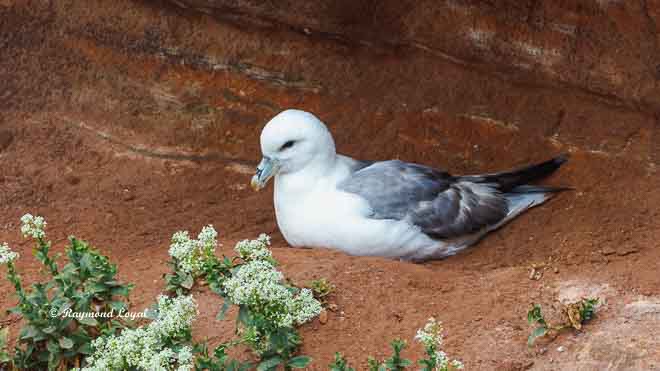Northern Fulmar (Fulmarus glacialis)
At first glance, a sitting fulmar looks very much like an ordinary gull. As I said, only at first glance. White head, dark-blue wings and a massive beak. It is the beak that gives final clarity on the real identity. A fulmar has a strange-looking tube-nosed beak, which is why the entire group is called tube-noses.
The Northern Fulmar, as is the case with the majority of seabirds, only comes to shore for breeding. Most of the year they spend their time out on the north Atlantic. Their southernmost breeding colony is on the German island Heligoland, where they can be found on the western and northeastern side of the island. They breed on cliff ledges and their behaviour is strikingly different from the gregarious and loud Northern Gannets.

Description - Characteristics: Northern Fulmar
Breeding – Clutch – Measurements – Habitat – Diet - Threats
Taxonomy:
Order: Procellariiformes
Family: Procellariidae
Genus: Fulmarus
Species: Northern Fulmar
Scientific Name: Fulmarus glacialis
Names and Synonyms of the Northern Fulmar
Name in German: Eissturmvogel
Name in Czech: Buřňák lední
Name in Slovak: Fulmar ľadový
Name in Hungarian: északi sirályhojsza
Name in Croat: Sjeverni zovoj
Name in French: Fulmar boréal
Name in Spanish: Fulmar Boreal
Name in Portuguese: Fulmar-glacial
Name in Dutch: Noordse Stormvogel
Name in Italian: Fulmaro
Name in Iceland: Fýll
Name in Greenland: Qaqulluk
Name in Faroer: Havhestur, Náti
Name in Finnish: Myrskylintu
Name in Danish: Mallemuk
Name in Swedish: Stormfågel
Name in Polish: Fulmar
Name in Russian: Глупыш
Characteristics of the Northern Fulmar
Distribution: North Atlantic and North Pacific. Colonial breeder – mostly large colonies. The southernmost colony is on the German island Heligoland in the German Bight; more colonies are on the British Isles, Noway (Runde Island, Lofoten archipelago); Iceland, Faroe Islands, Svalbard, Franz-Joseph Island, Jan-Mayen Island, Nowaja Semlja; east and west coast of Greenland, New Foundland, Canadian arctic islands, East Siberia.
Movements: Juveniles are migrational. Only rarely in the Baltics and Mediterranean. Usually movements southwards to 43° N. Arctic breeders leave the breeding areas between November and February to move down south.
Habitat: Most of the time out on the ocean. Returns to land only for breeding.
Behaviour: Activity both diurnal and nocturnal, depending on availability of food. While breeding in colony mostly diurnal. Picks food from water surface.
Measurements
Size: 45-50 cm
Weight: 525-850 g
♂: 760-1000 g, Ø c 835 g
♀: 610-855 g, Ø c 700 g
Wingspan: 102-112 cm
Wing:
♂: 324-356 mm
♂: 309-337 mm
Voice: Mostly silent, especially on nest. In colony usually cackling, chattering and purring sounds.
Breeding
Maturity: First breeding usually between 6th-12th year.
Mating Season: Monogamous breeding pair. Mating before arrival at breeding area.
Clutches per breeding season1 clutch
Breeding: rarely early May, mainly from mid of May to June. Last juveniles fledge in September.
Nest: shallow scrape on cliff ledge and outcrops, usually close to shoreline, also in vegetation.
Clutch: mainly one egg, larger clutches by two females
Eggs: oval egg with white shell.
Egg Measurements:
Length: 65.5-81.5 mm
Width: 43.2-51.1 mm
Ø: 74.0x54.1 mm
Egg weight: 98-104 g
shell weight: 7.8-10.1 g; Ø = 8.5 g
Recurrent Clutch: no recurrent clutch recorded.
Incubation: 46-51 days, mainly between 52-53 days, both parents share the task of incubating.
Hatching: Most juveniles hatch between end of June to end of July.
Fledging: The chicken is guarded by one parent for the first 2 weeks, fledges after 46-51 days.
Miscellaneous
Food: Mollusks, fish, planktonic crustaceans, medusa, rubbish from ships, carrion, guts of dead fish, oil and fat.
Longevity: The latest known ringed bird reached an age of 43 years and 10 months.
Mortality: adult birds have an approximate survival rate of 97% per annum.
Threats: Lack of food, overfishing of sandeels in the North Sea; marine pollution by oil and rubbish; egg collection, where still permitted.
